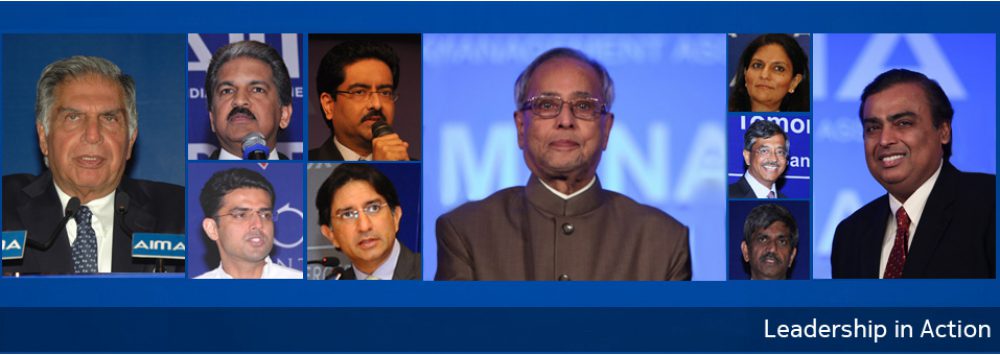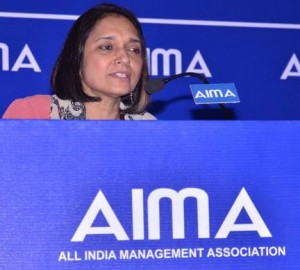I believe, innovation is countering inertia of change, which we all find very difficult to undertake. Its certainly about confronting gravity, and severing the tethers of what ties us to tradition. It’s scaling the walls of doubt and turning them into windows of opportunity. You must have heard this morning. It’s about doing new & different things. But it’s also about doing new and different things, differently! And, I think, doing a lot of new and different things, differently, there is a certain synergy that comes together and has thistransformative effect that innovation brings to organisations. As this book, ‘Orbitfuring Innovations’ has mentioned, it usually starts with the out of the box challenge. I think, Tanmay also mentioned it. ‘Tell me what the problem is’, and let’s look for that out of box idea, which is very clear definition of out of box challenge.
Innovation needs a lot of courage. You need to stand up to the change and you need to stand by the change. And I think that is a very critical aspect of innovation. If you don’t have the courage the stamina to stand by what is being created, it will fall by the way side. You must have seen a lot of passion and zeal, all of this morning and afternoon. That’s the call for innovation! The way it works is infectious and transcends the boundaries around you. Transcends the boundaries of reasons and metamorphosis all of them. It’s a drive of unfathomable proportion.You can’t even imagine how far this goes. IT CAN DRAW AND DRIVE TEAMS THAT ARE HIGHLY DISPERSED AND WIDELY ACROSS THE COUNTRY INTO ACTION.
Successful innovation certainly radiates with the zeal of the innovator. It is created and born from the zeal of the innovator. But it needs to forma collaborative team, because innovation, creating something new and different is not good enough for the sake of creating something new and different. There must be a value proposition somewhere. And a value proposition has to get a good rate of adoption for the consumer. So, innovation is successful only if it has a good rate of adoption. For that high rate of adoption, you need to have this very collaborative team, which will actually help to bring it alive. But the third very critical ingredient, I feel, for innovation isreally a good level of support from the top. So, the person who leads the organization or that team must be in complete support with the team that is driving innovation.
In one of the assignments that I did when I was a part of global beverages, everybody in the team ran their daily business. Everybody in the team had their innovation agenda sitting on their desks and I found that when you split both things and put it on the same desk. Each person had to do his daily business, run for profit, run for turnover, and also,report on how the innovation was doing. It keeps huge amount of interest going theirassignments.
Successful innovation is as much about creation as it is about excellent execution. Because if you want adoption and your innovation is directed to bring you business, it isn’tgoing toget any business, if you cannot get it to the consumer, in the way that you imagined it. So, innovation is about creation as much as about excellence in execution. And some of the examples what I am going to describe to you, I hope is going to help you bring this alive.It is certainly relentless work if you say, ‘Oh! I have had a tough year, I created this and it’s all over.’ NO! No good innovation, even if it gets diffused, can be said it’s done because please recognize that every second the world around us is changing. Every second thatconsumer who is going to buy your product or service is changing. He is getting influenced.If yourinnovation cannot keep itself refreshed and renewed, soon, it won’t be an innovation. So, it’s relentless hard work and it’s a lot of fun! And I think, people who are engaged in innovation really have a great time. At least I enjoy it. And I have been in innovation for a large part of my career and I have been fortunate to do that!Therefore, right at the beginning of my career, I was very fortunate to be a part if the crafting, creation, launch and establishment what has become and has come to be known as one of the most successful food innovations in this country. Any guesses? Yes! It’s Maggie. So, I have been very fortunate to be in the center of all the action around Maggie. Infact, my journey started when I joined Nestle in the year 1979 and the whole journey was about how innovation was a driving force behind every element of strategy.
Let me start from right at the beginning. What is a product? The first question that faced us was this. So, the product was something that Nestle sold. And sold a lot of it. And, they wanted to explore whether they could sell it in India.Thus, the first thing that we understood was that we had to ‘unchinese’ the noodles for Indians. Therefore, we studied a lot of food habits, what we eat, what they eat why do you eat it, who cooks it, etc. And as we started getting deep inside, we came to the conclusion that food as it gets the center of plate gets very traditional. So, what happens when the food gets very traditional, what happens? You don’t want to experiment. You want the same dal that your wife cooks, or the same Rajma that your mother cooks. You don’t want to experiment. So, we thought lets forget meal. We went back and studied non-meal foods. And we realized that other than samosa and pakodas there were no quick cooking snacks in this country. There was nothing. You know for example if I dripped into your house and I said I am famished, I want something hot to eat! You would struggle. You would make roti dal samosa pakoda or something like that. It would take you a long time. So we said yes, that is the window of opportunity. But we thought who in the family could bring this food item into the family. Is it going to be the housewife or the husband? Who is it going to be? Who will accept something new to eat? And obviously, the choice rested on the child.
And if you recall the advertisements from the year 1983, the communication focused on how much fun it was in having noodles. And all of them were the cues to make the product interesting for the children. So they would ask for it. But hold on! There is a problem to it. It’s not necessary that whatever the child asks for, he will get it. The problem was the gatekeeper, the mother. For her, this was a worm like alien. How would be solve this problem? So what we came intrinsic to the communication, the mother, the mother was always propagating the product. The child would ask for it, and the mother would say, “hey, give me 2 minutes and I will serve you something very nice”. Now, she was the person propagating the product, she was not the victim being demanded from.
Another one very important aspect, at that time, women who found shortcuts, those lazy, housewives, was positively oriented. She was always shown very happy to serve this product to the kids.
The next thing that faced us was, that if you want a lot of children to eat this product, you have to have a lot of children. Television was just starting to roll out in the 1980’s. You had a lot of very good programs like Ramayan, some cartoon network but there were a lot more children who were not accessible to television. So, where would you find the most kids? Schools! But how do we get to schools? So the whole concept turned to built fun, buteducative fun, in order to get entry into the schools. And at that time the schools were much more liberal. So there were Maggie quizzes being organized in schools so as to have theintellectual quotient rub-off on the product. So there was a lot of free sampling being done. I would stop here for a moment and tell you that in terms of excellence in execution, if you walked into a school and they told you that there are thousand students in this section of building and we have an intimation of 25 minutes because we wont allow you to disrupt our regular curriculum.That’s fair.
So, the way the whole activity was set up in those days was that in 25minutes every kid in the building was sampled. People were trained, there was a map drawn of where they had to go, samples were left in advance, they knew exactly what to say and exactly what to do. So, they spent only 1minute in every section and the brilliance of doing something is in the part of how we do it.
The product was the first flexible product for Nestle. So, how do you make the presence of the product in a shop come alive? How do you merchandise it? You cant make a flexible pack and stand, it would fall down! Plus, it was priced at Rs.2.50. It was not the high valued product like the can bottles. So, you needed to find cheaper solutions to merchandise as you could not afford to pay. Maggie never paid for displays. What did we do? Does anyone know? We used air space! No one had ever used air space by using hanging baskets. That was also made as a discipline. A lot of people found it tedious to go and hang baskets. Thus, it was leading to charge to hang baskets. So, the seniors who would go their with the team would hang baskets, so the sales team would follow them. In every sales meeting, there was a short training program to how to merchandise. It was a key ingredient. If you go into a dark dingy shop, you would probably not see it. And, we made a lot of fun out of it because in every meeting we would find the best basket filler and they all would be prized. Coming to the end, I would like to add that we had our own big B, the bacteria. Nestle was a milk company and they were very particular about hygiene. So everything used to be tested. But Maggie used a lot of spices and spices are not eaten alone. A little amount of bacteria is allowed in the spices because it goes through a lot of physical handling. But when we started receiving the spices, everything was getting rejected, as they didn’t meet the standards because someone had set the same stringent standards for spices. So, I actually had to go and work with the head in Switzerland to lay out a plan for acceptance of spices, so they could pass the spices into the factory. I think the zeal of the person in the center of the innovation is very important. But I can tell you that had that zeal not been communicated to the factory workers, the R&D people, sales people, we wouldn’t have had a successful innovation.
The above article is an excerpt from the speech delivered by Ms Sangeeta Talwar, Former Managing Director NDDB at AIMA’s Innovation Summit which took place in March 2014.




